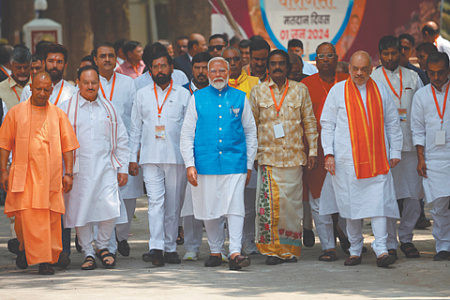
New Delhi is grappling with a significant foreign policy challenge as it seeks a response to punitive US tariffs, reportedly imposed over India’s energy trade with Russia. With Washington representing a destination for roughly 20% of Indian exports, the economic pressure is immense. Yet, for Prime Minister Narendra Modi, capitulating to such demands risks undermining his image as a strong leader and casting doubt on India’s strategic autonomy, prompting influential voices within his government to advocate for a return to the nation’s historical policy of non-alignment.
A powerful symbolic message was recently sent to Washington when Prime Minister Modi was photographed holding hands with Russian President Vladimir Putin and Chinese President Xi Jinping at a major regional summit. The gesture was widely interpreted as a display of unity among the three powers against unilateral pressure from the West, a message the White House publicly acknowledged. This moment of solidarity, however, was quickly followed by a counter-signal. Modi pointedly declined to attend a subsequent military parade in Beijing, a move underscoring India’s deep-seated security concerns over Chinese armaments that could be deployed along their disputed border.
This complex balancing act is rooted in India’s history. A brief but decisive border war with China in 1962, which ended in defeat for India, pushed the government under Jawaharlal Nehru into a closer relationship with the Soviet Union. Despite this, India remained a champion of the Non-Aligned Movement (NAM), which Nehru co-founded. The movement, born from the 1955 Bandung Conference and formally established in 1961, united newly independent nations in Asia and Africa under a commitment to avoid entanglement in Cold War military blocs and the expansionist ambitions of great powers.
While the Non-Aligned Movement now includes over 100 member states, its global influence has waned considerably. In recent years, Prime Minister Modi’s government has pragmatically moved away from NAM’s traditional tenets, fostering closer strategic and military ties with the United States and its allies, Japan and Australia, through the Quadrilateral Security Dialogue (QUAD). New Delhi views the QUAD as a crucial counterbalance to China’s growing power, though it officially frames it as a forum for dialogue rather than a formal military alliance. This pivot, however, has not stopped India from simultaneously conducting joint naval exercises with Russia, showcasing its multi-vectored foreign policy.
The current crisis sparked by US tariffs has thrust this strategic debate into the open. The economic and diplomatic benefits of a closer partnership with Washington are now weighed against the costs to India’s sovereignty. As prominent officials call for a return to the non-aligned principles clearly articulated by Nehru, Modi faces a difficult choice. Embracing the core foreign policy doctrine of a historical political rival—Nehru’s Indian National Congress party—presents its own domestic political complexities, leaving India at a critical juncture in defining its role on the world stage.
